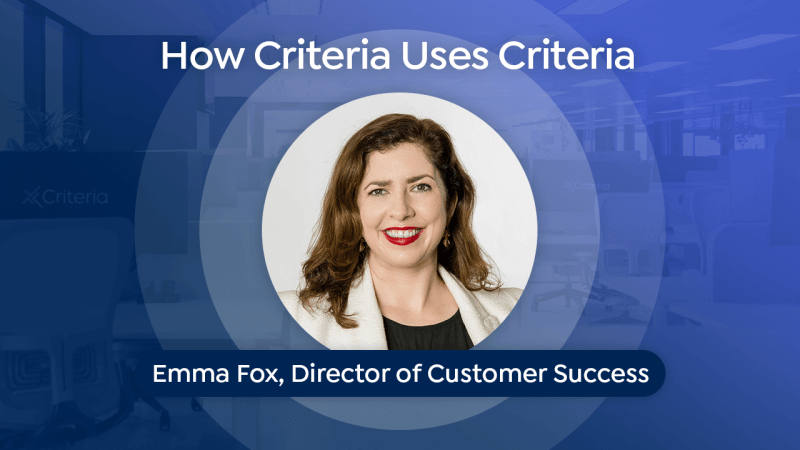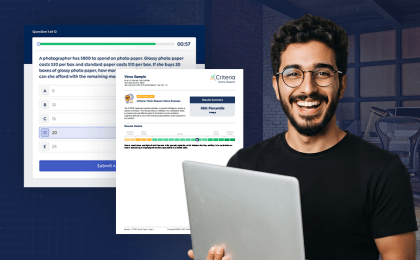This article is part of a blog series: “How Criteria Uses Criteria,” where business leaders at Criteria grant you an inside look at how we leverage our own platform to make informed talent decisions.
Thank you so much for joining us today. Please tell us about what you do here at Criteria and the different types of hiring obstacles you face.
Hello, I’m Emma Fox. I'm the Director of Customer Success at Criteria, so I'm responsible for hiring our awesome customer success managers (CSMs) who nurture our customers. I would say we're very big into succession planning and talent mobility here are Criteria. We love to be able to offer our team opportunities to develop and grow into different roles.
One of the big challenges we have is finding people at that entry level – where the candidates may not have had previous experience in customer service or software, or it may even be their first corporate role.
My goal is to find people that are going to be sales-driven, be able to hit their different metrics and goals, and to learn quickly on the job. It’s just as important that candidates are customer-centric, since our CSMs act as advocates for our customers. Moreover, I need people who can build rapport easily, especially internally. As a CSM, you work with so many different teams – product, dev, support, sales, marketing – to take care of your clients.
What do you do to get a clearer picture of the people you’re trying to hire?
Our assessments are incredibly powerful, especially when paired with the expertise of our consulting psych team. Illustrait, one of our behavioral personality tools, is one of my favorite assessments. I get so much valuable information on each candidate who comes through my pipeline. It's a fully customizable assessment based on competencies – the different traits or behaviors you expect to see in an individual.
I collaborated with our director of consulting psychology and together we mapped out what makes a successful CSM. This lets me target those key competencies from a hiring perspective, so that I only ask questions I know will predict success for this particular role. By building up this “success profile,” I can peak under the hood of each candidate to see what really drives them.
For example, I need to know if a candidate is happy speaking revenue with clients, if they are goal-oriented, and how conscientious they are. These are key traits for me because the data shows that people who are very motivated towards hitting goals tend to be top performers in this role. This allows me to identify candidates that will hit their quotas, retain their customers, and be really focused on their goals.
From Illustrait, I get a clear idea of what I can expect to see in the workplace, which is particularly valuable when we're hiring people who are just starting out in their career. Sometimes people struggle to fully demonstrate their abilities in their resume or interview, but by using my customized assessment I’m able to uncover their true potential.
Another tool that I love is video interviewing. Objective data is what really drives a fair and equitable candidate experience. Highly structured video interviews give everybody the same chance to prove themselves, but still allow candidates to inject who they are as a person into the process. It’s a great way to get to know a candidate more personally prior to extending a face-to-face interview to them.
I've also loved using our asynchronous video interviewing tool to answer different kinds of questions. I can give candidates more time to prepare something that will act as a sort of case study on their specific capabilities.
These tools sound incredibly powerful. So how do you integrate them into your overall hiring strategy?
Once I’ve got all the data points on a candidate – their assessment results, video interview, and resume – I'll look at their information in aggregate to make an informed decision about who I want to invite for a face-to-face interview.
At Criteria, we use a very structured interview process that focuses on job-relevant, behavior-based questions. I can use the candidate’s Illustrait results as the basis for some of my questions if there are any points that I want to dive deeper into. I start with structured questions that we ask everyone, but then if there's more information that I want to find out, I’ve got the ability to include specific questions to get more insight. Once I have completed an interview, I combine that insight with all those data points from their application to make a hiring decision.
This process allows us to hire as fast as possible, which is particularly critical in this talent market. These tools enable me to hire quickly and confidently, which increases my success with finding great talent and hiring for potential.
Once you've made this successful high-potential hire, do you find that you use these same tools post-hire, or do you use different ones?
There's another tool that we use called Develop. When someone starts, we'll walk through our Collaboration Guide to share how I and their coworkers tend to operate. Understanding the similarities and differences between our tendencies really speeds up their ability to get fully integrated into our team. It's explaining those differences and where we come from that helps build collaboration.
For instance, let’s say it’s someone’s first time meeting a coworker. That new hire can look them up, find their collaboration guide, and see what they need to be mindful of when communicating to have an effective meeting together. It gives you a new level of awareness that makes for easier collaboration in a hybrid or remote environment – particularly where we're not all even on the same continent! It's all about knowing how to interact with each other in the best way possible.
For me as a leader, I see my purpose as enabling my team to be super successful – whether at Criteria or beyond. What can I do for them and their career to make them successful in future roles? Be it here, be it in my team, be it in someone else's team. And the Criteria platform makes it so much easier for me to do that.
Emma, thank you so much for your time today. It's so impressive to see the power of these data-driven decisions in practice. Is there anything else that you'd like to share with us?
I would say if you're not hiring for potential, you are missing out on so much good talent in the market. We're doing a series called “More Than My Resume,” which I love, and it really shows that it doesn't matter what you studied, if you studied, what your last job was, if you've never worked in software… If we see that potential in you through our objective and data-driven tools, then we'll hire you because we really believe in potential and developing our teams to be super successful at Criteria!





